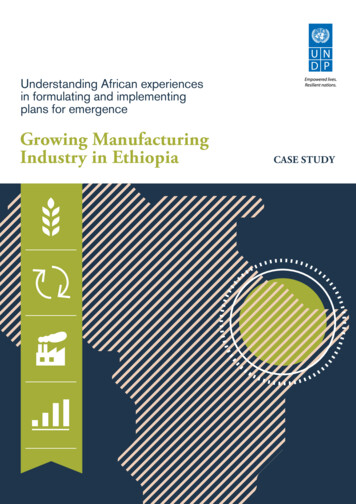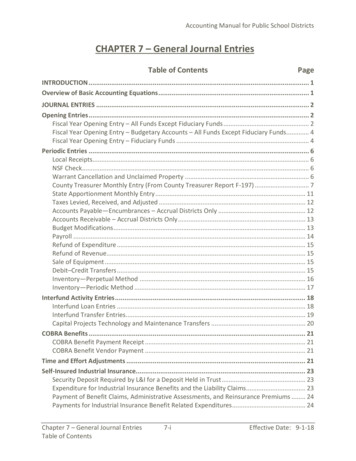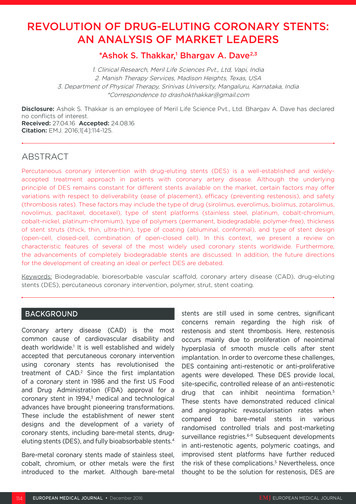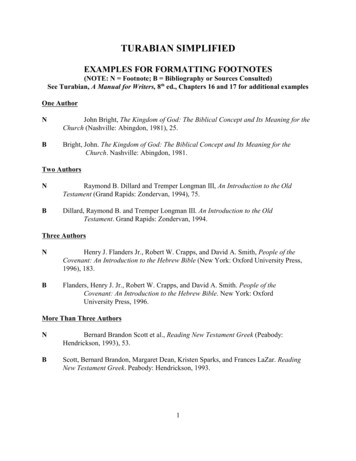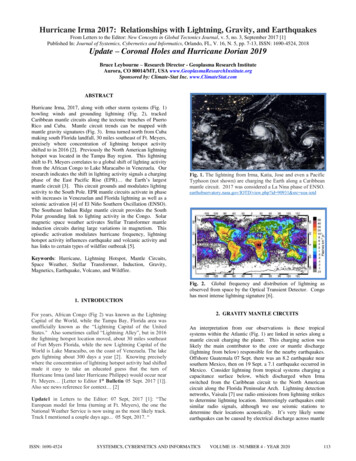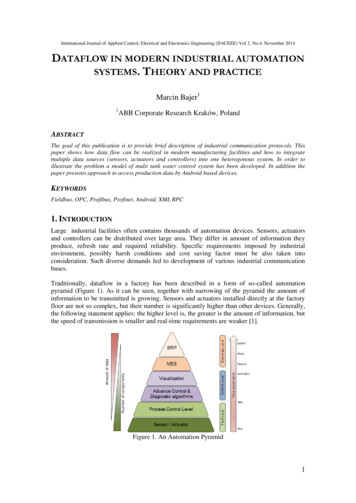
Transcription
International Journal of Applied Control, Electrical and Electronics Engineering (IJACEEE) Vol 2, No.4, November 2014DATAFLOW IN MODERN INDUSTRIAL AUTOMATIONSYSTEMS. THEORY AND PRACTICEMarcin Bajer11ABB Corporate Research Kraków, PolandABSTRACTThe goal of this publication is to provide brief description of industrial communication protocols. Thispaper shows how data flow can be realized in modern manufacturing facilities and how to integratemultiple data sources (sensors, actuators and controllers) into one heterogonous system. In order toillustrate the problem a model of multi tank water control system has been developed. In addition thepaper presents approach to access production data by Android based devices.KEYWORDSFieldbus, OPC, Profibus, Profinet, Android, XML RPC1. INTRODUCTIONLarge industrial facilities often contains thousands of automation devices. Sensors, actuatorsand controllers can be distributed over large area. They differ in amount of information theyproduce, refresh rate and required reliability. Specific requirements imposed by industrialenvironment, possibly harsh conditions and cost saving factor must be also taken intoconsideration. Such diverse demands led to development of various industrial communicationbuses.Traditionally, dataflow in a factory has been described in a form of so-called automationpyramid (Figure 1). As it can be seen, together with narrowing of the pyramid the amount ofinformation to be transmitted is growing. Sensors and actuators installed directly at the factoryfloor are not so complex, but their number is significantly higher than other devices. Generally,the following statement applies: the higher level is, the greater is the amount of information, butthe speed of transmission is smaller and real-time requirements are weaker [1].Figure 1. An Automation Pyramid1
International Journal of Applied Control, Electrical and Electronics Engineering (IJACEEE) Vol 2, No.4, November 20142. FIELD LEVELEach of the factory levels can be characterized by a specific set of communication protocolsused. Despite constantly increasing number of Ethernet based devices in the lower layers ofautomation systems, pure analog/digital signals or classic fieldbus system (Profibus, HART,Modbus RTU) are still commonly used for connection with sensors and actuators. In thefollowing part of the paper the most popular field level communication protocols are described.Usually they interconnect PLCs with sensors and actuators. In more complex or redundantsystems where data between PLCs is required, Ethernet based protocols or proprietary solutionsare commonly used.2.1. ModbusModbus is considered as one of the most popular protocols in industrial manufacturing. It isopen, easy to implement and robust. Author’s experience shows that it is common that modifiedversions of Modbus are used for communication between processors or modules in the system.Originally it was using RS232/RS485 as a hardware layer. Currently, Modbus was extended touse TCP/IP and Ethernet to transmit Modbus messages.Modbus is based on Master-Slave architecture. To access data, the master sends to the slave atelegram which contains: slave address, function code and data bytes. Each telegram hasadditional CRC to verify integrity of the received data.Slave address should be in range of 1-247, which limits number of slaves to 247. This limitationis not valid for Modbus TCP, where IP address is used to distinguish devices. Slave addressfield is used by Modbus TCP devices which composites of several slaves (i.e. gateways).Data access is based on well-defined addressing model. Four primary types of data tables werespecified: discrete inputs (single bit, read-only), coils (single bit, read/write), input registers (16bit word, read-only), holding registers (16 bit word, read/write). Elements in tables can beseparately accessed by combination of function code and address. For each of primary tablesaddress 16 bit address can be specified. Mapping Modbus addressing to real data in the device isa vendor specific decision. It is common all four tables overlapping one another to address thesame data [2].Although, real-time capabilities of Modbus TCP are not guaranteed, its performance isacceptable for most of industrial applications.2.2. ProfibusProfibus (Process Field Bus) was introduced in 1989 and described as International Standard inEN 50170 and IEC 61158/IEC 61784. Two variants are currently in use. The most popularProfibus DP (Decentralized Peripherals) communicates over RS-485 at distance between 100meters (up to 12 Mbps) and 1200 meters (minimally 9.6 kbps) [3], separate wires are used forpower supply. Earlier, Profibus has also been used for communication between PLC controllers,but now this option is less popular – it was replaced by Ethernet based protocols (i.e. ModbusTCP).Data is exchanged in a form of cyclic telegrams (DPV-0) and acyclic alarm andparameterization (DPV-1). Although, in most cases Master-Slave architecture is used byProfibus, both slave to slave communication (DPV-2) and multi-master are possible. Mediaaccess control (MAC) is Master-Slave based. If more than one master is configured, the right to2
International Journal of Applied Control, Electrical and Electronics Engineering (IJACEEE) Vol 2, No.4, November 2014control the bus has a Master which currently possess a symbolic token. When the token holdingtime for that master exceeds or the master has no more pending requests, the token is passed tothe subsequent master [4]. Communication real-time capabilities are guaranteed.The main disadvantage of Profibus is its cabling. Wiring and terminators are the most expensiveand very sensitive part of the system. Potential problems are difficult to troubleshoot. In someapplications fibre optics can be also used instead.Profibus PA (Process Automation) is much less popular. Profibus PA uses two-wire connectionwhich carry both power and data. It offers smaller throughput (31.25 kbit/s), but can be used inexplosive environments. Profibus PA and DP uses the same communication protocol and can belinked together with a special gateway device.2.3. ProfinetProfinet was designed as a successor of Profibus and was introduced to market in 2002. Itcombines well proven concepts of the previous standard with powerful features of Ethernet.Two specifications were described: Profinet CBA – for communication between components ofautomation system and Profinet IO – for integration of distributed IOs. Currently, only ProfinetIO is a living standard. Profinet IO Real Time (RT) protocol is capable to use standard Ethernetcabling and network equipment, but it is recommended to use dedicated switches which canprioritize Profinet traffic. Minimal cycle time of 1 ms is available. In order to satisfy higherperformance requirement (i.e. for motion control) Profinet IO Isochronous Real Time (IRT) wasintroduced. It requires special network components to reserve part of bandwidth for Profinettraffic. Cycle time of 250 µs are available with high degree of determinism (1 µs).In Profinet IO new communication profiles (i.e. ProfiSafe, ProfiEnergy, Sequence of Events)and features (Shared Device, Shared Input, Configuration in a Run) are constantly developedand implemented by the device vendors. Profinet become powerful but rather complex protocol.2.4. HARTHART is hybrid protocol which uses both analog 4-20 mA current loop and digital frequencyshift keying signal. Analog signal is used to transfer measured process value, digitaltransmission contains additional process parameters and sensor configuration. Data bytes aretransferred at the rate of 1200 bps, and can operate over long distance. Traditional sensors canbe directly integrated with HART enabled controller, in this way factory modification can bedivided into a few steps.2.5. CANCAN was originally developed for automotive industry, but it has also been adopted for use atthe factory floor. Several automation fieldbuses use CAN as the backbone technology (i.e.DeviceNet, CANOpen or SafetyBus). CAN is multi-master, when the bus is free any unit maystart sending data to other network nodes. A message consists of an identifier and up to eightdata bytes. Transmitter observes the bus, in case two devices start transmitting at the same timea message with higher ID has lower priority. Transmitter which is sending this message shouldstop.Multiple µP has hardware support for CAN. Speed of communication depends on length of thecable. It has maximal bit rate of 1 Mbit/s with the maximal bus length of 40 meters. Long bus,up to 270 meters, can work with the maximal speed of 250 kbit/s [5].3
International Journal of Applied Control, Electrical and Electronics Engineering (IJACEEE) Vol 2, No.4, November 20142.6. Wireless protocolsWe are observing explosive growth in popularity of wireless communication in consumerelectronics. This trend can be find also in a field of industrial applications. Nowadays, wirelesstechnology has matured to the point it can be safety applied for manufacturing. Its reliabilityand durability allow to use it not only for monitoring and asset management, but also for controlpurpose. Wireless solutions offer far more benefits than just reduction of cabling cost and easyintegration with existing systems. It also enables new potential applications (i.e. rotatingmachines, mobile robots, pipeline camera diagnostic. etc.).The wireless communication protocols can be divided into two types: those which transferpower together with information and those transferring only data. Although, wireless powertransfer is niche solution, a few such protocols will be described further in this paper.2.6.1. WirelessHARTWirelessHART is based on the proven and well established HART specification which has beenextended to ensure reliable and secure wireless data transfer. Wireless mesh technology wasapplied to provide robust, self-healing network. Figure 2 shows an idea of mesh network.Gateway is connected both to a host network and to a mesh. Multiple paths can occur betweenthe gateway and the mesh elements. If one pathway is blocked, network manager automaticallyswitches to redundant one. If new instrument joins the mesh, topology is automaticallyreconfigured.Each of network nodes has its own time slot for data transition. Time stamps are attached toeach telegram. WirelessHART offers several features to increase battery lifetime (transmissiononly on data change, threshold for detection of value change, modification of refresh rate baseon process value, collecting and sending data in packs).WirelessHART uses the same frequency as WiFi and Bluetooth. The bandwidth is divided into15 channels. Before transmitting, device checks whether channel is currently being used. Insuch case transmitter waits until next time slot and use a new channel.Host networkActive pathSecure joint procedureRedundant pathFigure 2. WirelessHART mesh topology [11]2.6.2. WiFiWiFi is a term to describe all Wireless Local Area Networks that conform to any of IEEE802.11 standards. There are two basic modes of operation: infrastructure-based and ad-hoc. Ininfrastructure mode each wireless client is connected to an Access Point (AP). Every twodevices need to communicate through an AP, which limits localization of them within range ofan AP. In ad-hoc mode devices can communicate directly between each other. The basic WiFiconfiguration had no provision of multi-hop - network nodes cannot be used as an intermediarydevices. Several mechanisms have been proposed how to add routing capabilities to WiFi and4
International Journal of Applied Control, Electrical and Electronics Engineering (IJACEEE) Vol 2, No.4, November 2014enable multi-hopping [7]. Recently, mesh networks were finally standardized under IEEE802.11s standard and can be applied in future instead of WirelessHART or ZigBee.WiFi is already in common use for a wide variety of industrial applications. It is being mainlyused as a replacement of wired Ethernet whenever it is difficult, expensive or impossible toinstall cables or system is often reconfigured.2.6.3. BluetoothBluetooth has been standardized in IEEE 802.15.1. Currently, its usage for manufacturing israther limited to tunneling wired interfaces (Ethernet, RS-485, CAN) to interconnect automationislands.Bluetooth Low Energy (Bluetooth 4.0) is a new standard of wireless communication. It isoptimized for low power consumption. Although, the standard is not compatible withpredecessors, many devices implement both classic and low energy version. The new standardwas created for low cost sensor applications with short data telegrams and working most of thetime in sleep mode.Anticipating a significant increase of popularity in customer electronics, especially smartphones, Bluetooth Low Energy technology has a big chance to be adapted for industrialpurpose. Sensors operating for several years on button-cell battery would find manyapplications in plant automation.2.6.4. Passive sensorsOne of challenges for wireless technology is powering devices. Available battery life time is notyet sufficient for many applications. Using cables to transfer power reduces mobility andincreases cost. Wireless energy transfer is one of the possible solutions to the problem.Typically, the energy is transferred via alternating magnetic field. Power loops are installedaround the production cell and fed by alternating current. Sensors inside have small coils whichpick up energy from a magnetic field and convert it to electric power. This idea was applied inABB’s WISA technology. The WISA stands for Wireless Interface to Sensors and Actuators.WISA system consists of two parts: WISA-COM responsible for communication and WISAPOWER for energy transfer [8]. The communication protocol is based on IEEE 802.15.1(physical layer) and customized for factory automation. It is now standardized byProfibus&Profinet International as Wireless Sensor Actuator Network (WSAN).Similar technology for wireless energy transfer is used by RfId tags, anti-thief devices andrecently in NFC payments. Especially, the NFC technology has potential to take advantage ofincreasing popularity of NFC chips in smart phones and be implemented in industrialapplications.Other interesting approach to passive sensors is based on Surface Acoustic Wave (SAW)phenomena. The solution utilize a piezoelectric effect to transduce an electric signal into amechanical wave which is distorted by measured physical value and converted back to electricsignal in next transducer. SAW technology allows to measure various physical parameters liketemperature, torque, strain or pressure. The main advantage of such sensors is that they aresmall, can be mounted on rotating parts, do not require battery and are immune to magneticfields.2.6.5. OthersThere are multiple other fieldbuses: EtherCAT, EtherNet/IP or LonWorks to name just a few.Author of this publication has chosen for more detail description only those communicationprotocols in which he has the greatest experience. Currently, there is no dominant industrialprotocol used at factory floor, and due to different requirements it is believed it will not change.The main observation is increasing popularity of Ethernet base fieldbuses.5
International Journal of Applied Control, Electrical and Electronics Engineering (IJACEEE) Vol 2, No.4, November 20143. SCADA LEVELThe SCADA term stands for Supervisory Control And Data Acquisition. It generally refers to aset of applications to control and monitor an industrial process. The OPC (OLE for ProcessControl) was mostly created to enable interoperability at the SCADA level. Currently, OPCtechnology is a widely accepted industrial communication standard that enables exchange ofdata between multi-vendor field level devices and software for advance control andvisualization. Multiple OPC specifications were defined, currently the most widely spread isOPC Data Access. OPC DA deals only with real-time process data. For historical data andalarms separate specifications were created.In OPC DA with each process value time stamp and signal quality value is associated. The OPCtechnology has a Client – Server architecture. Usually OPC Server is an application running onPC, communicating with industrial equipment via proprietary interface. Manufacturing MessageSpecification (MMS) was proposed to standardize exchanging data between networked devicesand computers [9], but it had little success.An OPC Client can subscribe in Server chosen data with a minimal refresh rate. The maindisadvantage of OPC DA technology is its dependency to Microsoft’s DCOM/COM. It limitsusage of OPC DA in non-Windows base systems. As a solution for this problem OPC XML hasbeen proposed, but till now there are not many implementations of it. In practice, OPC UnitedArchitecture (OPC UA), which include features of all previous OPC standards, has a chance tobecome a true replacement of OPC DA. OPC UA is based on Web Services and ServiceOriented Architecture (SOA). SOA bases on the idea of service as an independent piece ofsoftware with specified interface and is capable to provide described functionality. It is a crossplatform solution. It offers two protocols for communication between Server and Clients. One isa binary TCP protocol, optimized for high performance and the second is XML based webservice. OPC Foundation provides exemplary implementations of OPC UA for ANSI C/C ,Java and C#. Server can be implemented directly in a device which reduce need of installingthis software on the PC.To provide vertical integration most of SCADA systems can be configured to be the OPCServer for higher levels of the factory. In this case OPC UA is a step towards interoperability,while using XML, generic SOAP clients can access data.4. ENTERPRISE LEVELEnterprise network is used mainly by high level production management applications(Enterprise Manufacturing Intelligence). The network traffic does not contain real-time data, buttrend is to increase that amount of production data processed and stored. Company executivesmore often relay on those information to make critical decisions in near real-time.To exchange data between multiple Enterprise Resource Planning software modules (i.e.Material Resource Planning (MRP), Customer Relationship Manager (CRM), Supply ChainManagement (SCM) and more) common vendor independent architecture is needed. ServiceOriented Architecture (SOA) is well established solution in this area. It is frequent that bothservice interface and communication protocol are defined with XML. Other solution for datasharing between modules of ERP is common database.5. CONCLUSIONS AND FUTURE TRENDSIn approach described in Figure 1 usually there is defined number (or even single) gatewaysbetween tiers of the pyramid. Data exchange is taking place between different levels, but rarelybetween devices within the same level. Recently, due to increase of popularity of Ethernet,those both statements are not always valid. Growing number of sensors equipped with Ethernetport allows accessing process data directly by the devices located in highest layers of an6
International Journal of Applied Control, Electrical and Electronics Engineering (IJACEEE) Vol 2, No.4, November 2014automation pyramid. Multiple clients can access the same data provider. Information can beread from sensors at the same time both by the process controllers and SCADA/MRP systems.It is more common that industrial devices provide embedded web page for configuration. Itreduce need of installing and managing proper version of configuration software. This solutionis also more platform independent - sensor configuration can be performed both on theWindows, Linux or smartphone. Advances in real-time web design techniques allows tosmoothly show not only the static device configuration, but also process variables.Another aspect of Ethernet popularity at the factory floor are changes in the way howmaintenance is performed. Many companies operate their production facilities spread all overthe world. It is often the case, that to solve not standard problem or perform non-routinediagnostic, expertise not available locally at the plant is needed. Providing remote access tofactory devices enables possibility to involve several experts placed in distant locations to solvethe problem [10].We can also observe emergence of new forms of service offered by automation devices vendors.To ensure uninterrupted operation of their equipment they offer extended service contractswhich involves early diagnostic, preventive maintenance and emergency help base on remoteaccess. Term Intelligent Devices Management (IDM) was created to describe software whichallows manufacturers to monitor and manage remote equipment, systems and products viathe Internet [11]. Providing adequate level of security is a demanding task, but it is a win-winscenario for both customer and device vendors. Customers will receive help in better and costeffective assets management. Manufactures can use this data to improve their devices.6. EXEMPLARY INSTALLATIONDedicated demo stand has been created to demonstrate in practice data flow in an industrialplant. The model of a process consists of pipes, valves, and two containers for water. The upper,cylindrical shape tank, which is considered in this study as main, has gravity outflow to thelower one used as the water reservoir. Main tank can be refilled by pump which is connectedwith water reservoir through delay element. The purpose of the regulator is to control the pumpspeed to maintain a constant water level in the upper container. Various kind of disturbance canbe introduced to the system (i.e. changing flow resistance, simulating leakages). Field devicesare interconnected with PLC via various industrial field buses. OPC standard is used to accessPLC data.6.1. Data flowTo show how numerous fieldbuses can be integrated, field devices has been chosen in the wayalmost each of them uses different communication protocol. Main object is separated from theprocess controller part. Profibus over fiber is used to make interconnection. Dedicated modulewas used to extend internal PLC commulication bus by Profibus DP. Numerous extensionsmodules were installed to handle different fieldbus connections (Profibus PA, HART, AC800MModuleBus).To provide Ethernet network main object was connected with the PLC controller by dedicatedEthernet switches with fiber extension. ABB 800xA Industrial Platform was installed on the PC.It provides a comprehensive set of features for production plant management. Only a smallsubset of its functionalities was used to show process variables. Few screens have beenprepared. They allow to perform standard maintenance operations (i.e. manual control of motorspeed, valve position change, enabling automatic level control. etc). Since all PLC variables areavailable via OPC, SCADA software from other vendors may be used.To simulate low bandwith connection (approx. 1 Mb) with enterprise level network Ethernetover Bluetooth tunnel was established.7
International Journal of Applied Control, Electrical and Electronics Engineering (IJACEEE) Vol 2, No.4, November 20146.2. Control algorithmPreparation of the control algorithm was a subject of separate paper [12]. Model of the objecthas been prepared and identified. The system has been divided into a few elements: pump, maintank and reservoir. Each of them has been described with separate differential equation. Pumpspeed is estimated by the drive (SZ-1) base on internal model of motor.Several control algorithms have been realized. As the most basic a single PID has been used.This solution is not very effective in this case since the object has high inertia and large delaysintroduced by piping. In next step, idea of cascade PID has been used to better compensate flowdisturbances. The system was divided into two parts – fast changing flow control and slowchanging level control (Figure 3). The additional control loop allows to react faster on flowdisturbances.Process PID1Set level-Set flow Set speedPID2-e-sτG2(s)G1(s)Actual flowActual levelFigure 3. Cascade PID controlTo fully eliminate delay introduced by the piping, Smith predictor has been implemented(Figure 4). Assuming that the model of the process is correct, its output is cancelled by outputfrom real object. Hence, the feedback signal used by the regulator consists only of the outputfrom non-delayed process.-Set level Set speedPIDG(s)eActual level-sτ-e-sτmGm(s) - Set level PIDSet speedG(s)e-sτActual level-Gm(s)Figure 4. PID control with Smith predictorThe most complex control algorithm which was realized is based on Model Predictive Control.The idea of MPC control is to cyclically solve optimal control task with initial condition equalto estimation of the current state of the object. Only the first control vector is used as the inputof the object. The model of the system was linearized and discretized in working point. Kalmanfilter was used to estimate state of the object. Due to limited performance of PLC most of thecalculations is done offline for given object state.8
International Journal of Applied Control, Electrical and Electronics Engineering (IJACEEE) Vol 2, No.4, November 2014OPC DAKY1,KY2,KY3,KY4LT2PDT-1XML-RPCLT1Digital IOHARTProfibus PACorporatenetworkSZ-1ModuleBus over fiberFT1Profibus DPProfibus DPProfibusDPProfibusover thernetover fiber800xA ITPlatformRS232 over EthernetOPCOPCFigure 5. Communication flow in prepared demo standFigure 5. Picture of demo stand6.3. Protection relayREF543R feeder terminal is designed to be used for protection, control, measurement andsupervision of medium voltage networks. Based on measurements of currents, voltage,frequency, etc., the protection device is programmed to disconnect parts or equipment of thesystem. In the described automation object the protection relay is measuring motor feed currentand voltage. It provides various measurements (i.e. THD, power, frequency, power factor. etc.).With such approach it is also possible to observe how ACS800 drive is controlling motor speed.REF543R provides transient disturbance recorder which is able to record up to 16 currents orvoltages signals with high frequency.9
International Journal of Applied Control, Electrical and Electronics Engineering (IJACEEE) Vol 2, No.4, November 2014Information is read from protection relay by RS-232 and Ethernet tunnel. Virtual COM port isavailable on the PC. Dedicated OPC server is running on the PC to allow accessing this data byOPC clients.6.4. Vendor independent to OPC DAThere are a few implementations of DCOM in Linux, but in fact they are almost never used forcreating OPC in non-Windows based systems (Android, QNX, iOS) [13]. Tunneling approach ispopular to enable vendor independent access to data provided by OPC DA. One solution is touse OPC DA to OPC UA tunnel, second is to prepare custom software which translates OPC tochosen protocol.In the presented system, dedicated software was prepared to translate OPC to XML-RPC. Thereare several reasons for using XML based protocol. XML-RPC uses HTTP as a transportmechanism to exchange XML data between client and server. It provides less functionalitiesthan SOAP and number of transferred data is larger than while using JSON. The mainadvantage of XML-RPC is that it can be easy debug with Wireshark. There are a few openimplementations of XML-RPC for various operating systems. Android application was preparedto check feasibility of the idea (Figure 6). Additionally, PC gateway was prepared to run on thePC where OPC server is installed. Since security was not a concern in this situation, it ispossible to access process anywhere within corporate network.Figure 6. Main view of prepared Android application7. SUMMARYTo sum up, this paper describes data flow in the typical industrial object. It was shown that withdedicated equipment it is easy to integrate multiple industrial communication fieldbuses intoone system. Growing popularity of Ethernet is a game changer in area of field levelcommunication. It is expected that popularity of Ethernet based protocols will increase.Currently, OPC DA is most popular standard for accessing process data by SCADA levelapplications. Its usage is limited to Windows and it is expected that OPC UA will replace it.Service Oriented Architecture is used for communication between elements at the enterpriselevel software. Growing popularity of SOA increases interoperability and allows to createvendor independent solutions.10
International Journal of Applied Control, Electrical and Electronics Engineering (IJACEEE) Vol 2, No.4, November 2014REFERENCES[1]Dietrich R., Industrial Ethernet. from the Office to the Machine, Harting, 2005.[2]Modbus Application Protocol Specification V1.1b3, Modbus Organization, 2012.04.[3]Profibus Installation Guideline for Commisioning, Version 1.0.2, PI International, 2006.[4]Tovar E., Vasques F., Cycle Time Properties of the PROFIBUS Timed Token Protocol, IEEProceedings - Software, 1998.[5]Zhu Yu, CAN and FPGA Communication Engineering, Diplomica Verlag, 2010.[6]HART Communication protocol, ABB Information Bulletin, IB/INST–016 Issue 1.[7]Wei H.Y., Rykowski J., Dixit S., WiFi, WiMAX and LTE Multi-hop Mesh Networks : BasicCommunication Protocols and Application Areas, Wiley, 2013.[8]Steigmann R., Endresen J., Introduction to WISA, ABB White Paper, July 2006[9]Overview and Introduction to the Manufacturing Message Specification (MMS), Rev 2, SISCO,1995[10]Hollender M., Collaborative Process Automation Systems, ISA, 2010.[11]Dong J., Network Dictionary, Javvin Technologies Inc., 2007.[12]Bubak M., Sterowanie i diagnostyka obiektów nieliniowych na przykładzie układu dwóchzbiorników, Praca magisterska, Kraków 2010[13]What is DCOM? DCOM implementations. http://linuxopc.info, (access 2013.10.30)AuthorsMarcin Bajer graduated from Uni
automation systems, pure analog/digital signals or classic fieldbus system (Profibus, HART, Modbus RTU) are still commonly used for connection with sensors and actuators. In the following part of the paper the most popular field level communication protocols ar e described. Usually they interconnect PLCs with sensors and actuators.





